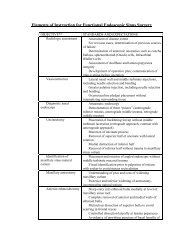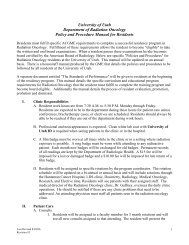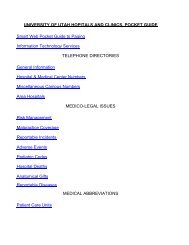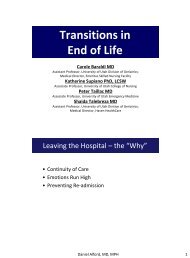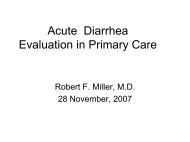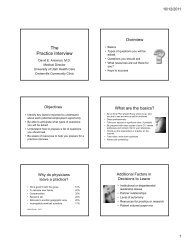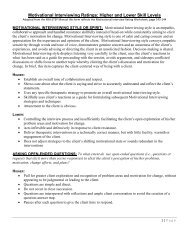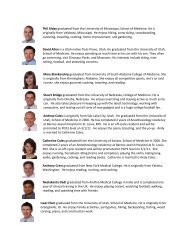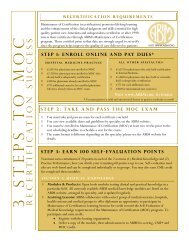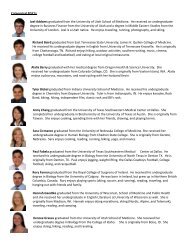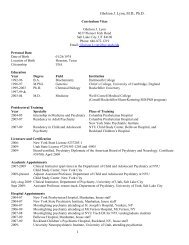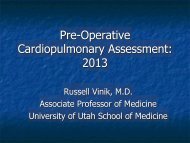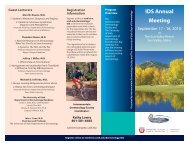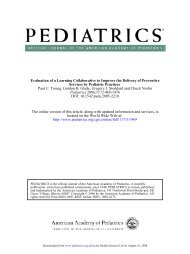Winter 2008/2009 - University of Utah - School of Medicine
Winter 2008/2009 - University of Utah - School of Medicine
Winter 2008/2009 - University of Utah - School of Medicine
Create successful ePaper yourself
Turn your PDF publications into a flip-book with our unique Google optimized e-Paper software.
News Notebook<br />
Reynolds Foundation Grant Helps U<br />
Strengthen Geriatric Training and Care<br />
A report from the Institute <strong>of</strong> <strong>Medicine</strong><br />
published in April <strong>2008</strong>, “Retooling for<br />
an Aging America: Building the Health<br />
Care Workforce” highlights the critical<br />
deficiency in healthcare providers with<br />
the training needed to provide care for<br />
older people. “As the population <strong>of</strong> older<br />
adults grows to comprise approximately<br />
20 percent <strong>of</strong> the U.S. population, they<br />
will face a health care workforce that<br />
is too small and critically unprepared<br />
to meet their health needs.” The 7,000<br />
geriatricians in the United States will not<br />
be able to meet these demands and older<br />
people will receive the majority <strong>of</strong><br />
their care from the 220,000 primary<br />
care physicians.<br />
In response to these projections<br />
the <strong>University</strong> <strong>of</strong> <strong>Utah</strong> <strong>School</strong> <strong>of</strong><br />
<strong>Medicine</strong> launched an innovative program,<br />
“Advancing Geriatric Education<br />
Through Quality Improvement” or “AGE<br />
QI” in 2006. The program is aimed at<br />
Ge<strong>of</strong>frey Tabin, M.D., Honored With American Academy <strong>of</strong><br />
Ophthalmology <strong>2008</strong> Outstanding Humanitarian Service Award<br />
John A. Moran Eye Center<br />
Ophthalmologist Dr. Ge<strong>of</strong>frey<br />
Tabin received the Outstanding<br />
Humanitarian Service Award at the<br />
American Academy <strong>of</strong> Ophthalmology<br />
(AAO) meeting in Atlanta, Georgia<br />
this past November. The Outstanding<br />
Humanitarian Service Award was created<br />
to recognize individuals involved<br />
in humanitarian projects, including<br />
participation in charitable activities,<br />
care to the indigent and community<br />
service. Out <strong>of</strong> a membership <strong>of</strong> more<br />
than 27,000 ophthalmologists, Dr.<br />
Tabin is one <strong>of</strong> only two physicians to<br />
receive this prestigious award for <strong>2008</strong>.<br />
Dr. Tabin serves as the Director<br />
<strong>of</strong> the Division <strong>of</strong> International<br />
Ophthalmology at the John A. Moran<br />
Eye Center, <strong>University</strong> <strong>of</strong> <strong>Utah</strong> in Salt<br />
Lake City, <strong>Utah</strong>. He is a specialist in<br />
6<br />
helping primary care physicians in the<br />
state provide higher quality care for their<br />
older patients. The school is now using<br />
AGS QI, which is based on an initiative<br />
originally developed through the<br />
Michigan Geriatric Education Center<br />
to help more than two dozen clinical<br />
practices in <strong>Utah</strong> upgrade care<br />
for their aging patients.<br />
The program is funded by a grant<br />
awarded to the SOM by the Donald<br />
W. Reynolds Foundation “Aging and<br />
Quality <strong>of</strong> Life” program. Mark A.<br />
Supiano, M.D., pr<strong>of</strong>essor and chief<br />
<strong>of</strong> geriatrics and executive director <strong>of</strong><br />
the U <strong>of</strong> U Center on Aging, is principal<br />
investigator for the $2 million grant<br />
that supports comprehensive projects<br />
designed to strengthen geriatrics training<br />
for medical students, residents and<br />
practicing physicians.<br />
Through the onsite educational<br />
program, a <strong>Utah</strong> medical school geriatrics<br />
corneal disease and refractive surgery.<br />
He is currently conducting international<br />
ophthalmology missions as<br />
part <strong>of</strong> the United Nations Millennial<br />
Villages Project in Bonsaao, Ghana,<br />
where he and Moran ophthalmologists<br />
Paul Bernstein, Alan Crandall, and Bob<br />
H<strong>of</strong>fman, and a team <strong>of</strong> health care<br />
specialists, recently examined 4,600<br />
people and performed<br />
159 surgeries in a very<br />
remote and logistically<br />
difficult area.<br />
Dr. Tabin also<br />
founded the Himalayan<br />
Cataract Project in<br />
1994, with Dr. Sanduk<br />
Ruit, a native <strong>of</strong> Nepal.<br />
Since the founding<br />
<strong>of</strong> the project, Drs.<br />
Tabin and Ruit have<br />
faculty member and a geriatric nurse<br />
educator work with the entire staff in<br />
a given primary care practice presenting<br />
a 2-hour geriatrics review, then help<br />
the staff develop, complete and<br />
analyze the outcomes <strong>of</strong> a quality<br />
improvement project focused on a<br />
common geriatric condition.<br />
Because more than a third <strong>of</strong> older<br />
people fall each year and many experience<br />
significant complications resulting<br />
from fall-related injury, all ten <strong>University</strong><br />
Health Care Community Clinics are<br />
participating in AGE QI and are directing<br />
their QI efforts by conducting a fall<br />
prevention program. The fall prevention<br />
program systematically screens all<br />
Community Clinic patients age 65 years<br />
and older to identify those at risk for falling.<br />
They then conduct an evaluation to<br />
identify strategies – such as home safety<br />
assessments or exercise programs – to<br />
decrease this risk.<br />
directly restored sight to over 65,000<br />
people. This year in Nepal alone more<br />
than 120,000 people will have their<br />
sight restored, due in large part to the<br />
extraordinary efforts <strong>of</strong> the Himalayan<br />
Cataract Project. Drs. Tabin and Ruit<br />
are working to develop other international<br />
eye care programs in India,<br />
North Korea and other areas <strong>of</strong> Africa.<br />
Ge<strong>of</strong>frey Tabin, M.D., in Nepal<br />
Kathy Pedersen, MPAS, PA-C<br />
Appointed to the Board <strong>of</strong><br />
Directors <strong>of</strong> the Global Health<br />
Education Consortium<br />
<strong>University</strong> <strong>of</strong> <strong>Utah</strong> Physician Assistant<br />
Program faculty member, Kathy<br />
Pedersen, MPAS, PA-C has been appointed<br />
to the Global Health Education<br />
Consortium (GHEC) Board <strong>of</strong> Directors<br />
for a term <strong>of</strong> 2 years. PA educators have<br />
been involved in GHEC for the past 10<br />
years. The mission <strong>of</strong> GHEC is to foster<br />
international health medical education in<br />
curriculum, clinical training, career development,<br />
and international education<br />
policy. GHEC addresses health needs,<br />
human rights, and global workforce<br />
issues. Over 70 North American medical<br />
schools are represented in the GHEC.<br />
Ms. Pedersen’s background and<br />
interest area is studying, facilitating and<br />
cataloging the global development <strong>of</strong><br />
physician assistants. “I have an interest<br />
in learning about the different processes,<br />
educational models, and intended outcomes<br />
<strong>of</strong> physician assistant (PA) education<br />
outside the United States.” She is<br />
also interested<br />
in fostering<br />
international<br />
health medical<br />
education in curriculum,<br />
clinical<br />
training, career<br />
development,<br />
and international<br />
education policy.<br />
She has been<br />
on the faculty <strong>of</strong><br />
the <strong>Utah</strong> Physician<br />
Assistant Program<br />
for 20 years, facilitated global electives<br />
in Papua New Guinea and Thailand,<br />
and has helped to host delegations from<br />
these countries, in addition to Russia and<br />
Ghana. She also has served on international<br />
committees <strong>of</strong> the American<br />
Academy <strong>of</strong> Physician Assistants<br />
and Physician Assistant Education<br />
Association (PAEA) for the past 10 years.<br />
<strong>Utah</strong> Biomedical Informatics Department<br />
to Partner with <strong>University</strong> <strong>of</strong> Texas at Brownsville<br />
<strong>University</strong> <strong>of</strong> <strong>Utah</strong>’s nationally<br />
recognized doctoral program in<br />
Biomedical Informatics received<br />
a grant <strong>of</strong> $975,000 from the<br />
National Institutes <strong>of</strong> Health to<br />
foster a new partnership with<br />
their program and the <strong>University</strong><br />
<strong>of</strong> Texas at Brownsville (UTB).<br />
This bridging partnership will:<br />
1. Provide an interactive Master’s Program<br />
between UTB and the U <strong>of</strong> U which<br />
would adequately prepare minority<br />
students having an interest in the field<br />
<strong>of</strong> biomedical informatics for acceptance<br />
to the U <strong>of</strong> U BMI Ph.D. program;<br />
2. Provide mechanisms for acceptance<br />
and funding by the U <strong>of</strong> U BMI<br />
Department for bridging students who<br />
satisfy the Ph.D. entrance requirements;<br />
3. Closely monitor students’ progress and<br />
provide activities as needed to fill gaps<br />
and promote their success in the<br />
program; and<br />
4. Provide an effective and measurable<br />
News Notebook<br />
Kathy Pederson and PA student Kelly Keller in Kikori Village<br />
in the Gulf Province <strong>of</strong> Papua New Guinea.<br />
She authored the PAEA White Paper<br />
on “International Physician Assistant<br />
Education”. Her Masters work included<br />
A Survey <strong>of</strong> International Activities <strong>of</strong><br />
United States Physician Assistant Programs.<br />
The PAEA International Activities<br />
Committee has continued using this<br />
survey yearly since she conducted the<br />
original survey in 2003.<br />
means <strong>of</strong> evaluating the success <strong>of</strong><br />
the program.<br />
Biomedical Informatics is a relatively<br />
new field <strong>of</strong> study, but it is growing very<br />
rapidly. It is now viewed as essential,<br />
not only to the delivery <strong>of</strong> high quality<br />
healthcare, but also to the advancement<br />
<strong>of</strong> all the biomedical sciences. Although<br />
most students and many faculty members<br />
at institutions <strong>of</strong> higher learning are still<br />
unfamiliar with the field <strong>of</strong> Biomedical<br />
Informatics, it <strong>of</strong>fers many challenges for<br />
research, creativity and career opportunities<br />
for individuals at the doctoral level.<br />
7



